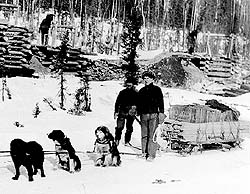 |
 
 |
 |
HARDSHIPS
Some mail carriers considered
the hardships they endured as part of the job; life in the North was harsh. And while the prospect of facing below zero-degree weather for most of the year and
complete days of darkness during other parts of it prompted many gold seekers to turn back, the dream of gold gave others the hope to persevere under such conditions. Thomas Kay revealed some of these difficulties in a letter sent to his father on August 7, 1898:
| |
I have reached Klondike at last after struggling for 5 long [weary weeks?] over the [Strickland-Tailor?] trail . . .
it has been a disastrous trip to all who came over the Stikeen route, it has cost us over 600 dollars and I lost 6 months time worked hard and landed here in rags, hungry and dead broke, some people have lost more and a few have lost their lives.67
|
The owner of the dog-team earned income by transporting merchandise, letters and/or passengers.
 |

Freighting on Bonanza Creek, Yukon,
ca. 1900 (detail)
© Public domain
National Library and National Archives
of Canada, C-000399 |
Carrying merchandise to the mines could bring in as much as $150 per day; the charge for delivering letters was $1 each; and a passenger accompanying the dog-team would have to pay approximately $500.68 In addition to the financial incentive, mail carriers working in the late 1890s were also motivated by the knowledge that the letters they carried to the North filled an important void for the many people who were isolated from family and friends. They knew that the letters they carried were often the only contact that the gold seekers had with the rest of the world.

|
 |